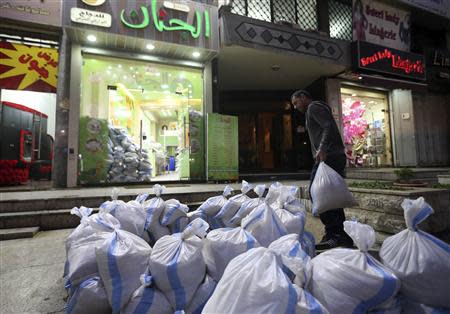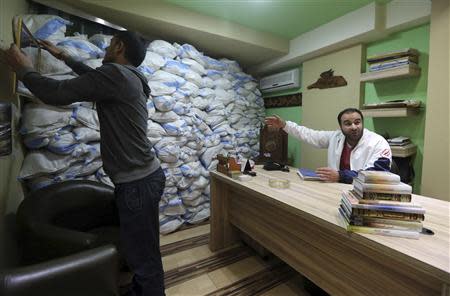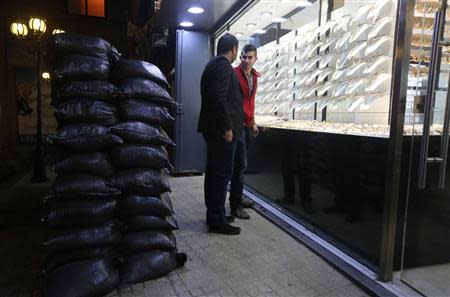Sandbags and security in Shi'ite Beirut after bombings
By Dominic Evans and Laila Bassam BEIRUT (Reuters) - Eight years ago Hassan Ghamlouche's jewellery shop was gutted when Israeli jets bombarded the Hezbollah-controlled district of southern Beirut where he works. Now a wall of sandbags stands in front of the glittering gold in his shop window to protect Ghamlouche and his customers from a new threat - a wave of car bombs which have struck the capital's Shi'ite neighborhoods in the last six months. Dozens of people have been killed in four bombings targeting the Hezbollah stronghold. The first in July struck just 100 meters from Ghamlouche's shop, and two more explosions this month suggest the pace of attacks may be stepping up. Rockets were also fired into Shi'ite southern Beirut last summer and a twin suicide bombing at the nearby Iranian embassy compound killed at least 25 people in November. Iran is the main patron of Hezbollah, the powerful Shi'ite militant group which fought a 34-day war with Israel in 2006 and also plays a leading role in Lebanese politics, with two ministers in the country's caretaker government. Al Qaeda-linked Sunni militants have claimed responsibility for some of the attacks and threatened more, saying Hezbollah's intervention in Syria's civil war alongside President Bashar al-Assad's forces makes it a legitimate target. The bloodshed and warnings of deeper sectarian conflict have alarmed many in the Shi'ite neighborhoods where the army, Hezbollah and local shopkeepers are all stepping up security against further attacks. "These measures provide 70 percent to 80 percent protection from shrapnel, heat or blast," Ghamlouche said of the black sandbags piled up in front of his shop. Across the road, welders were fixing metal plates across the front of his workshop while workers planted trees in the street's freshly dug central reservation - a move designed to deter car bombers by restricting room for anyone to park outside spaces now chained off for residents and shopkeepers. At the entrance to the neighborhood, the army searched cars, while a soldier in an armored vehicle checked their registration plates against a list of wanted vehicles. Beirut airport, next to the Mediterranean Sea on the southern approach to the city, has also stepped up security checks, while two centers of Shi'ite religious learning on the old airport road are now protected by concrete blocks and a line of freshly painted black and yellow metal barriers. EMPTY STREETS On Hadi Nasrallah Street, the main street running through the Hezbollah suburbs of south Beirut, traffic is noticeably lighter. Parking places under the main overpass have been sealed off to prevent would-be bombers leaving cars there. "The roads are empty because people are scared," said Ayman Bazzoun, who runs a shop on the street named after the slain son of Hezbollah leader Sayyed Hassan Nasrallah. "If people have no reason to, they won't leave home," he said. "People are not going out a lot - they call for delivery." For many residents, the security measures are a bleak reminder of Lebanon's 1975-1990 civil war when Beirut streets were turned into frontline positions. Raw nerves are further frayed by alerts which spread through social media - mostly false alarms - of more potential attacks. Five days ago Hezbollah officials blocked off a main road and summoned residents through loudspeakers to come down from their apartments and identify their cars after the group received information about another possible attack. For building materials salesman Ahmad Sharafeddine, protecting his shop was simply a matter of re-arranging his goods. Sandbags which he usually sells to construction firms were piled up outside the shop, while inside the window another protective wall was built from sacks full of ceramic plaster. "Every day three or four customers come to buy sandbags to protect their shops," he said, sitting at his desk less than 50 meters from the site of two bombings this month - the second of which struck last week. A white car with a smashed windscreen was still there, next to a large portrait of Iran's late Ayatollah Ruhollah Khomeini. (Writing by Dominic Evans; Editing by Mark Trevelyan)





